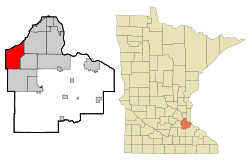
Back بورنسفيل Arabic بورنسفيل (داكوتا) ARZ برنزویل، مینهسوتا AZB Burnsville (Minnesota) Catalan Бернсвиль (Миннесота) CE Burnsville (lungsod sa Tinipong Bansa, Minnesota) CEB Burnsville Czech Burnsville (Minnesota) German Burnsville (Minnesota) Spanish Burnsville (Minnesota) Basque
This article contains content that is written like an advertisement. (November 2018) |
Burnsville | |
|---|---|
 Grande Market Square at Nicollet Avenue and Burnsville Parkway is the cornerstone of the Heart of the City project. | |
| Nickname: South of the River | |
 Location of the city of Burnsville within Dakota County, Minnesota | |
| Coordinates: 44°46′04″N 93°16′39″W / 44.76778°N 93.27750°W | |
| Country | United States |
| State | Minnesota |
| County | Dakota |
| Founded | 1855 |
| Established | 1858 |
| Incorporated | 1964 |
| Government | |
| • Type | Mayor-council government – Executive form |
| • Mayor | Elizabeth Kautz |
| • City Manager | Gregg Lindberg |
| Area | |
| • City | 26.98 sq mi (69.89 km2) |
| • Land | 24.94 sq mi (64.59 km2) |
| • Water | 2.05 sq mi (5.30 km2) |
| Elevation | 971 ft (297 m) |
| Population | |
| • City | 64,317 |
| • Estimate (2022)[3] | 63,936 |
| • Rank | US: 603rd MN: 14th |
| • Density | 2,579.18/sq mi (995.82/km2) |
| • Metro | 3,693,729 (US: 16th) |
| Time zone | UTC−6 (Central (CST)) |
| • Summer (DST) | UTC−5 (CDT) |
| ZIP Codes | 55306, 55337 |
| Area code | 952 |
| FIPS code | 27-08794 |
| GNIS feature ID | 0640669[4] |
| Website | burnsvillemn.gov |
Burnsville (/ˈbɜːrnzvɪl/ BURNZ-vil) is a city 15 miles (24 km) south of downtown Minneapolis in Dakota County, Minnesota. The city is situated on a bluff overlooking the south bank of the Minnesota River, upstream from its confluence with the Mississippi River. Burnsville and nearby suburbs form the southern portion of Minneapolis–Saint Paul, the 16th-largest metropolitan area in the United States, with about 3.7 million residents. At the 2020 census the population was 64,317.[2]
The name Burnsville is attributed to an early Irish settler and land owner, William Byrne. His surname was recorded as "Burns" and was never corrected.[5]
Burnsville stands on land that once contained a village of Mdewakanton Dakota. Later, it became a rural Irish farming community. Burnsville became Minnesota's 14th-largest city in the 2020 census following the construction of Interstate 35. Now the ninth-largest suburb in the metro area and a bedroom community of both Minneapolis and Saint Paul, it was fully built by the late 2000s. Burnsville's downtown area is called Heart of the City with urban-style retail and condominiums.[6] The Burnsville Transit Station serves as the hub and headquarters of the Minnesota Valley Transit Authority, providing regional bus service to five other suburbs.
Burnsville is home to a regional mall (Burnsville Center), a section of Murphy-Hanrehan Park Reserve, 310-foot (94 m) vertical ski peak Buck Hill, and part of the Minnesota Valley National Wildlife Refuge.
- ^ "2020 U.S. Gazetteer Files". United States Census Bureau. Retrieved July 24, 2022.
- ^ a b "Explore Census Data". United States Census Bureau. Retrieved November 24, 2023.
- ^ Cite error: The named reference
USCensusEst2022was invoked but never defined (see the help page). - ^ "US Board on Geographic Names". United States Geological Survey. October 25, 2007. Retrieved January 31, 2008.
- ^ "Burnsville 76; A Community History". Burnsville Heritage Committee. 1976. Archived from the original on July 31, 2009. Retrieved September 8, 2007.
- ^ Maler, Kevin (April 30, 2006). "Suburbs Want Downtowns of Their Own". The New York Times.
